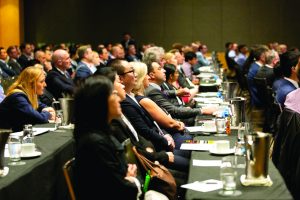By Yemi Oluwi, Co-Chair, Australia Working Group, FIX Trading Community, and Head of Technology, National Stock Exchange of Australia and Eugene Budovsky, Co-Chair, Australia Working Group, FIX Trading Community, and Head of Low Touch Equities Execution, Australia, Credit Suisse.
 The FIX Conference has been running annually in Sydney for the past 11 years, and is considered the premier equity trading event in Australia. The fact that we are co-chairs of the FIX Australia Working Group adds an element of bias to this assessment, however the conference on the 17th of October truly lived up to this standard. The event sported a diverse and interesting line-up of speakers ranging from CEOs, to regulators, to quantum-computing experts. The key theme throughout the conference touched broadly on how technology is changing the face of trading, and many of the presenters focused on how they are taking advantage of technological developments to either become more efficient, or more profitable, or both.
The FIX Conference has been running annually in Sydney for the past 11 years, and is considered the premier equity trading event in Australia. The fact that we are co-chairs of the FIX Australia Working Group adds an element of bias to this assessment, however the conference on the 17th of October truly lived up to this standard. The event sported a diverse and interesting line-up of speakers ranging from CEOs, to regulators, to quantum-computing experts. The key theme throughout the conference touched broadly on how technology is changing the face of trading, and many of the presenters focused on how they are taking advantage of technological developments to either become more efficient, or more profitable, or both.
Proceedings opened with a fascinating fire-side chat with Virtu Financial CEO Doug Cifu hosted by Joe Kassel (former Head of Exposure Management at AMP). The term “fire-side chat” often invokes a degree of cynicism, however Doug and Joe really lived up to the format with a very candid conversation covering Virtu’s history, the recent ITG acquisition, Doug’s expensive passion for ice hockey, and the colourful story of Doug’s twitter handle @Dougielarge (spoiler alert: it involves multiple A-list rappers). Tying back to the theme of using technology to become more profitable and efficient, Doug believes that the key to Virtu’s success is their brand new tech stack built in 2008 which is very scalable. Commenting on the KCG acquisition, Doug remarked “The world screams for efficiency. KCG did not have a revenue problem, they had an expense problem”.

As technology changes the face of trading, regulation must follow. Calissa Aldrige’s ASIC Regulatory Updates covered focus on what are now old staples of cyber security and data collection, expanding into technological resilience of all participants. In order to enhance regulatory capability, better tools are being acquired, including the use of AI and Machine Learning. Computing needs are also driving ASIC to consider utilising cloud computing for their own purposes – an indication of how far cloud technology has come.
RegTech is increasingly being used to manage the industry’s regulatory burden, and the trends in this area were discussed by a panel of compliance and RegTech specialists. Ben Gatward, Tower Research head of Compliance for Asia, commented that with increased regulatory sophistication comes an increased burden on financial intermediaries, and that “Humans just can’t do all the work, RegTech is inevitable”. The panel heard that the most common areas where RegTech is currently having an impact are data collection/reporting, and data analysis/decision making.
Trading tools are always evolving to meet new demands. Evolution of current tools was discussed in the morning, where there was a look at several improvements on handling parent-child order flow. Just before the coffee break there was a look at how AI is impacting trading and workflow automation. While still early days, some use cases are seeing significant benefits and there is a good level of excitement in the area. AI is also being applied to the area of TCA to bring new insights out of the data. These new insights lead to profitable changes in trading. Flextrade’s Dan Enstedt, when asked what the buy-side really want, answered simply “Liquidity.” Modern trading tools are an increasingly important part of the solution to that problem.
A FIX conference wouldn’t be complete without gazing into the crystal ball gaze in to some very advanced technology. Quantum computing fits this bill very well and Lloyd Hollenberg gave an overview of how quantum computing works and what the potential application are. Quantum computing threatens to make traditional encryption obsolete by being able to crack uncrackable keys. Just the fear of that happening is altering the way encryption is being assessed and planned for. So even when a technology has not matured – or even arrived – it can have impacts on the present.

The conference rounded out with two panels covering current buy-side priorities. Jason Lapping (Dimensional), Will Psomadelis (Schroders) and Teresa Woodward (TRowe Price) shared some insight into how their firms are using trading to add value to the investment process, with some extremely varied approaches discussed. Schroders developed an alpha decay model to prime the execution strategy, but takes a relatively hands-off approach to the underlying design of broker algos, preferring to harvest execution data to construct their own forecasting models. The output of this process is used to predict which algo, from a diverse group each with their own objectives and behaviours, will perform better for a specific order in given market conditions. Dimensional on the other hand uses its their own internal TCA to fine-tune its desired trading behaviour, and feed very specific expectations down to their broker panel on how the algos should operate. While the approaches are very different, both have resulted in significantly reducing frictional costs.

Janelle Manchee, IFM Investors; Andrew Briscoe, First Sentier Investors
After the sessions it was time for more informal mingling at the cocktail reception. The more relaxed setting allows for more intimate questioning and meetings. We’ve always found this a valuable addition to the formal sessions; greater understandings of the people we deal with leads to more trust and better outcomes.

Putting the conference together is the effort of many, many people and a lot of collaboration from individuals in the industry – a key strength and reason it brings such a great and diverse body of knowledge together. This gives a good overview of the topics covered, however in the short space we’ve been given it hasn’t been possible to mention everyone. We are extremely grateful to all those involved for providing their time and valuable expertise to the conference. It couldn’t have happened without them. We are grateful for all those people and organisations that contributed, and the support both Credit Suisse and NSX have provided to us to make this happen.
We are looking forward to next year – with 2020 vision!
